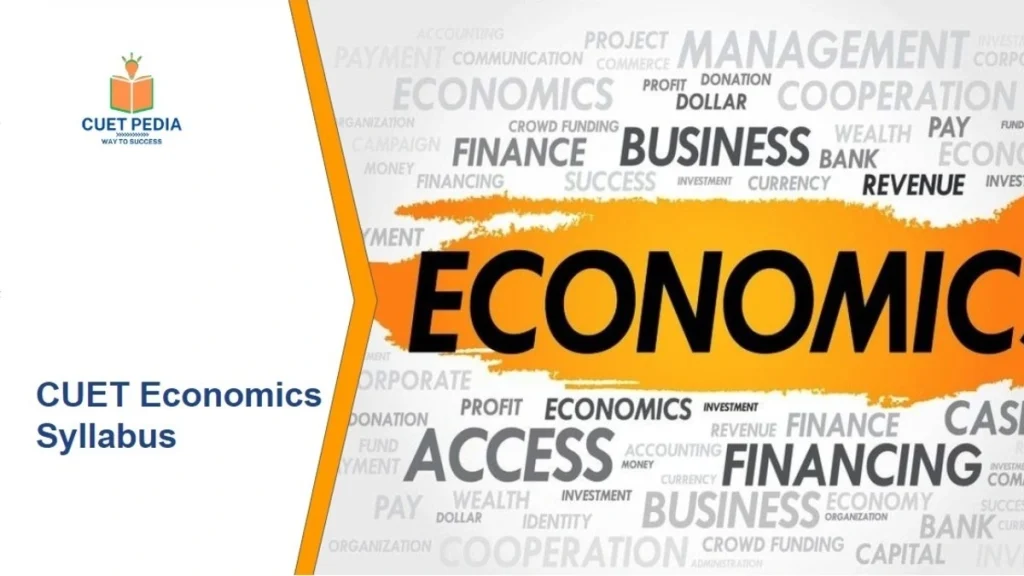Here we have provided the details about the CUET Economics syllabus. The CUET exam is conducted to offer admission to various UG programs of central/private/state universities in India. The questions are asked from each unit of the economics syllabus for the CUET exam.
CUET economics is one of the subjects asked in Section 2 of the exam is economics (Domain Specific Subject). Economics studies the creation, exchange, and consumption of goods and services. Economics focuses on the actions and interactions of economic agents and the operation of economies. Get the CUET UG economics syllabus PDF to learn the topics better.
CUET Economics Syllabus 2025
The economics CUET syllabus has 2 sections in total. Each of these 2 sections has a portion that is divided into multiple smaller sections, all of which are equally important from the CUET exam point of view. The two main sections are basic macroeconomics and the development of the Indian economy. The components are all connected in some manner. To fully understand each of these concepts, a student needs to study them in the CUET economics syllabus PDF. Each section should receive the same amount of attention and time from a candidate.
Download CUET UG Economics Syllabus PDF
To download the CUET economics syllabus PDF, go to the official website. This may seem challenging, so you can use the direct link below to quickly and conveniently download the economics syllabus PDF in Hindi and English.
Unit-Wise CUET Economics Syllabus 2025
The economics syllabus for the CUET exam can be confusing if the topic list is not divided into subsections. Important topics, including microeconomics, macroeconomics, and other economics-related subjects, are part of the economics CUET syllabus and are given in the table below.
Unit | Topic |
Introduction to Microeconomics |
|
Consumer Behavior and Demand |
|
Introductory Macroeconomics | |
National Income and Related Aggregates — Basic Concepts and Measurement |
|
Determination of Income and Employment |
|
Money and Banking |
|
Government Budget and the Economy |
|
Balance of Payments |
|
Indian Economic Development | |
Development Experience (1947-90) and Economic Reforms since 1991 |
|
Current challenges facing the Indian Economy |
|
Development Experience in India |
|
CUET Economics Preparation Tips
Students who want to pass this exam should use the CUET economics material and follow the general directions. In the text that follows, we’ll provide four crucial CUET preparation tips that all students, regardless of their topic of study, should follow to perform well on the exam:
- Practice, Practice, Practice, but appropriately. For a good result on the CUET exam, preparation is crucial. The sample papers, practice exams, and questions from CUET previous years papers must all be solved by candidates.
- The candidate should be well-versed in the CUET exam pattern and syllabus. CUET aspirants are required to be knowledgeable about the whole economics syllabus.
- Make a preparation strategy and follow it. Creating a study plan is essential before starting the exam preparation. Applicants must set aside enough time for each topic and prepare in advance. They must establish realistic and achievable targets to make the preparation manageable.
- The secret to long-term success is revision. Exam preparation calls for extensive review. Applicants should keep aside at least 2-3 weeks for revision.
Best Books to Cover CUET UG Economics Syllabus
CUET books are crucial to completing the economics CUET syllabus. Students are urged to construct curated notebooks to write, learn, and revise their book learnings in addition to the following reliable and helpful economics books.
- NCERT Class 11 Economics Textbook Part I
- NCERT Class 11 Economics Textbook Part II
- NCERT Class 12 Economics Textbook Part I
- NCERT Class 12 Economics Textbook Part II
- Microeconomics and Macro Economics by Sandeep Garg
Also Check,
CUET Economics Syllabus FAQs
No! The official economics CUET Syllabus has not changed recently. Even so, the National Testing Agency which administers the exam will give prior notice if any modifications are made.
The economics syllabus has 2 main units. Each of these 2 sections has a portion that is divided into multiple smaller sections, all of which are equally important to the paper. These are Indian Economic Development and Introduction to Macroeconomics. See the economics CUET syllabus.
The experts’ recommendations for the top CUET economics books include Sandeep Garg’s Microeconomics and Macroeconomics, the NCERT Class 11 and Class 12 Economics Textbooks, and more.
Visit the official website cuet.samarth.ac.in to obtain the CUET UG economics syllabus PDF. Or, you can download the syllabus more quickly and easily by clicking on the direct link provided in the post above.
One of the topics discussed in Section 2 is economics (CUET Domain Subject). The CUET economics domain subject syllabus has two units in total. Economics studies the creation, exchange, and consumption of goods and services.
